颜料防脱与平复折痕:Consolidating Pigments and Reinforcing Creases
配图一:The silk support and paper linings of this detail of the portrait of Daisan are creased and broken.
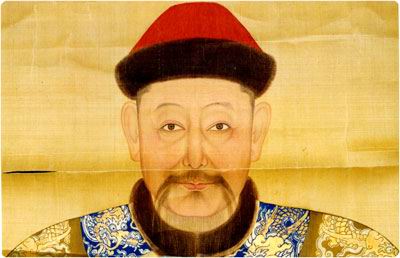
As a hanging scroll ages, it dries out andbecomes less flexible. Repeated rolling and unrolling causes themounting structure to crease or crack and eventually break. Thesecreases force the pigments on the painting surface to loosen andseparate from the silk support and cause paint losses in the image. Theextent of this problem also depends upon the age of the painting, howfrequently it was rolled and unrolled, and the quality of the materialsand techniques that the artist used. For example, in this portrait ofDaisan, a major leader during the early Qing dynasty (1644–1911), theanimal glue binder that was mixed with the painting's pigments morethan a century ago has lost its holding strength. As a result, thepigments have become powdery and easily fall from the silk surface.
配图二:A Sackler conservator uses a vacuum table to consolidate pigments of another hanging scroll.
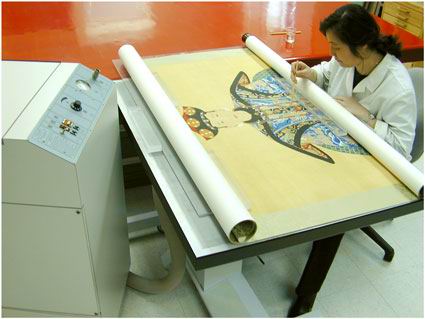
In this case, the loose (exfoliating) pigmentswere consolidated, or adhered in place, using a traditional animal gluebinder. The solid glue was dissolved in warm water to a 1 percentconcentration and applied with a brush or sprayer over the unstablepigments. This process, which takes several hours, was repeated inareas needing better adhesion. Areas where the pigments are coarse orthickly applied were consolidated using a vacuum table (see left). Thetable's strong suction pulled the animal glue binder through the thicklayers of pigments and into contact with the silk support beneath, thusensuring stable consolidation.
配图三:The consolidated pigments of Daisan's portrait are now stable, and the crease has been reinforced.
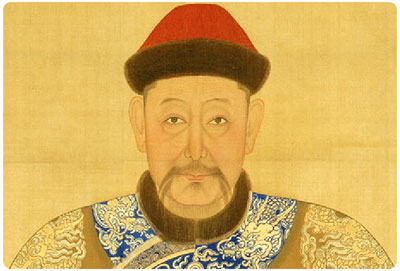
The stabilized pigments are no longer in dangerof coming (cleaving) off the surface of the painting when the portraitis handled and displayed. The creases in the mounting support are nowreinforced with strips of paper applied from the back. These paperstrips minimize the support's effects and deter further damage to thepainting.
________________________________
重新装裱:Reusing or Replacing Mounting Silks
配图一:The old mounting silk surrounding this portrait of Lirongbao's wife is creased, torn, and dirty.
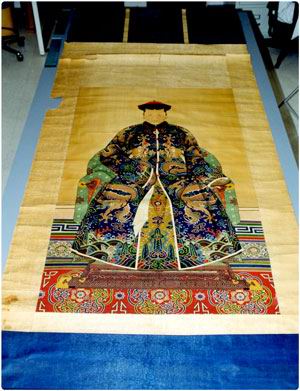
The colorful silks that are part of the backing,or "frame," for the portraits form an important part of the painting'shistory. When possible, conservators reuse old mounting silks that arein good condition and are appropriate to the painting in terms of colorand age. In these cases, the silk mounting fabric is removed, cleaned,and remounted around the painting.Sometimes the silk is simply worn or damaged beyond repair, as wasthe case with the portrait of Lirongbao's wife. The old mounting silkwas extremely soiled and stained. It is also torn and broken, and largepieces were missing. These silk fabrics had become so weak and brittlethat they no longer support the painting safely. Even after cleaning,they could still have shown signs of wear, fading, and stains. Theconservator and curator decided to remove the old mounting and replaceit with new silk.
配图二: New silks are placed around the painting to help the conservator andcurator select an appropriate combination of colors for the newmounting.
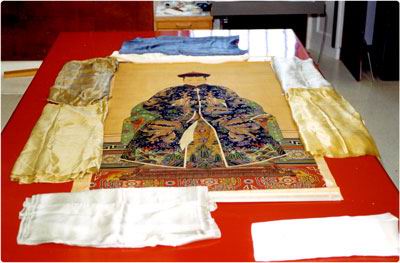
The conservator and curator selected new silkfabrics that are historically accurate and visually harmonize with thepainting. Pattern, color, and the style of the mounting were all takeninto consideration. For example, a bright yellow silk decorated withcertain birds or dragons would be appropriate for an imperial portrait,while a more subdued tan goes well with this portrait of the emperor'smother-in-law. Since the mounting must complement the painting, thesilk is often dyed to soften colors and to make the fabric look olderso it blends with the age of the painting. The fabrics are then linedwith thin Chinese paper, and wheat starch paste is used to adhere thepainting to the mounting. This process takes several weeks to complete.
配图三:The new mounting both highlights the portrait and provides a stable support for displaying the scroll.
Portrait of Lirongbao's Wife (act. late 17th century). China, Qing dynasty, 18th to 19th century. Hanging scroll; ink andcolor on silk; image only, 177.6 x 98.6 cm. Arthur M. Sackler Gallery,Purchase—Smithsonian Collections Acquisition Program, and partial giftof Richard G. Pritzlaff, S1991.129
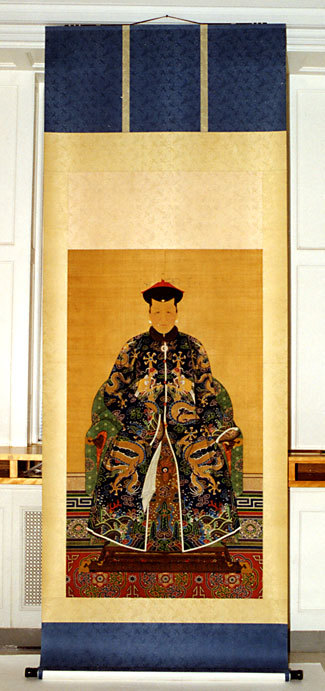
The new mounting silks were dyed to a shade thatharmonizes with the age, color, and style of this portrait. The newfabrics make a durable yet flexible mounting that both shows thepainting to its best advantage and creates a safe support for thescroll's display and handling.
The new mounting silks were dyed to a shade thatharmonizes with the age, color, and style of this portrait. The newfabrics make a durable yet flexible mounting that both shows thepainting to its best advantage and creates a safe support for thescroll's display and handling.